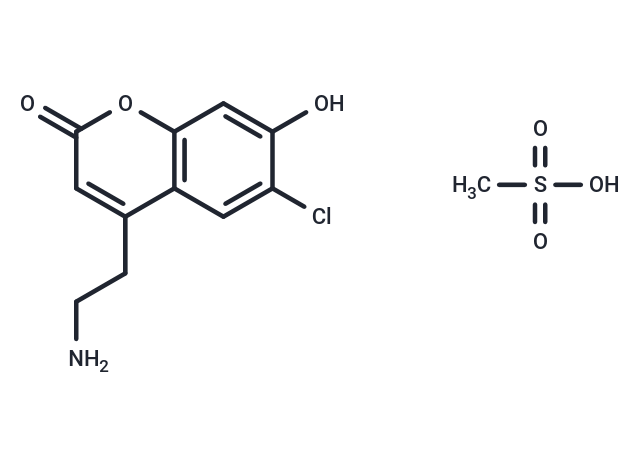Shopping Cart
Remove All Your shopping cart is currently empty
Your shopping cart is currently empty
FFN 102 mesylate is a pH responsive fluorescent false neurotransmitter (FFN), a selective dopamine transporter (DAT) and VMAT2 substrate. Exhibits no significant binding to a panel of 38 CNS receptors, including dopamine and serotonin receptors. Inhibits dopamine uptake. Excitation maxima are 340 nm at pH 5 and 370 nm at pH 7.5. Emission maximum is 435 nm at both pH 5 and 7.5.FFN 102 mesylate is a Ph-responsive fluorescent pseudoneurotransmitter (FFN) that acts as a substrate for selective dopamine transporters (DAT) and VMAT2.

| Pack Size | Price | USA Warehouse | Global Warehouse | Quantity |
|---|---|---|---|---|
| 1 mg | $30 | In Stock | In Stock | |
| 5 mg | $67 | In Stock | In Stock | |
| 10 mg | $101 | In Stock | In Stock | |
| 25 mg | $173 | In Stock | In Stock | |
| 50 mg | $247 | In Stock | In Stock | |
| 100 mg | $358 | In Stock | In Stock | |
| 200 mg | $497 | - | In Stock |
| Description | FFN 102 mesylate is a pH responsive fluorescent false neurotransmitter (FFN), a selective dopamine transporter (DAT) and VMAT2 substrate. Exhibits no significant binding to a panel of 38 CNS receptors, including dopamine and serotonin receptors. Inhibits dopamine uptake. Excitation maxima are 340 nm at pH 5 and 370 nm at pH 7.5. Emission maximum is 435 nm at both pH 5 and 7.5.FFN 102 mesylate is a Ph-responsive fluorescent pseudoneurotransmitter (FFN) that acts as a substrate for selective dopamine transporters (DAT) and VMAT2. |
| In vitro | The absorption spectra of FFN102 exhibited pH dependence: the absorption maximum shifts toward 331 nm at lower pH values and to 371 nm at higher pH values, corresponding to the protonated and deprotonated forms, respectively [1]. |
| Cell Research | I. Monitoring of neuronal electrical activity 1. Material preparation 1) FFN 102 mesylate solution: Dissolve FFN 102 mesylate in an appropriate amount of DMSO or other suitable solvent, usually at a concentration of 1-10 µM. Neuron sample: Cultured neuronal cells, or sliced neural tissue. 2) Culture medium or experimental buffer: Usually use a culture medium suitable for neurons (such as DMEM) or an appropriate physiological buffer. 2. Experimental steps 1) Cell treatment: Incorporate FFN 102 mesylate into cultured neuronal cells or slices, usually for 30 minutes to 1 hour. 2) Fluorescence imaging: Use a fluorescence microscope or imaging device with an excitation wavelength of 450 nm and an emission wavelength of 510-550 nm to observe the fluorescence signal. 3) Electrical activity detection: Monitor the electrical activity of neurons by changes in fluorescence signals and analyze its changes in different potential states. II. pH-dependent fluorescence 1. Experimental steps 1) Incubate FFN 102 mesylate under different pH conditions. 2) Use a fluorescence spectrometer to record the response of its fluorescence intensity to pH changes. 3) Quantify the pH changes inside and outside the cell based on the changes in the fluorescence signal. III. Neurotransmitter release study 1. Apply stimulation to neurons to induce neurotransmitter release. 2. Use FFN 102 mesylate to detect the release of neurotransmitters and observe the fluorescence changes. |
| Molecular Weight | 335.76 |
| Formula | C12H14ClNO6S |
| Cas No. | 1883548-92-2 |
| Smiles | O=C1OC=2C=C(O)C(Cl)=CC2C(=C1)CCN.O=S(=O)(O)C |
| Color | Red |
| Appearance | Solid |
| Storage | keep away from direct sunlight | Powder: -20°C for 3 years | In solvent: -80°C for 1 year | Shipping with blue ice/Shipping at ambient temperature. | ||||||||||||||||||||||||||||||||||||||||
| Solubility Information | DMSO: 45 mg/mL (134.02 mM), Sonication is recommended. H2O: 6 mg/mL (17.87 mM), Sonication is recommended. | ||||||||||||||||||||||||||||||||||||||||
Solution Preparation Table | |||||||||||||||||||||||||||||||||||||||||
H2O/DMSO
DMSO
| |||||||||||||||||||||||||||||||||||||||||
| Size | Quantity | Unit Price | Amount | Operation |
|---|

Copyright © 2015-2025 TargetMol Chemicals Inc. All Rights Reserved.